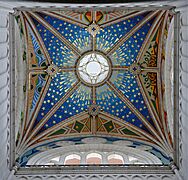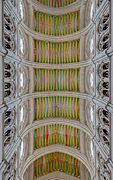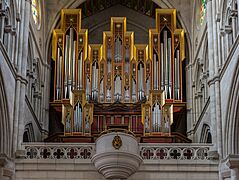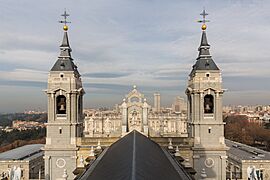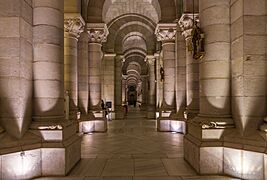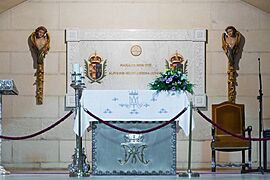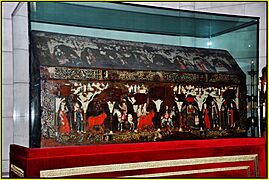Almudena Cathedral facts for kids
Quick facts for kids Almudena Cathedral |
|
|---|---|
| Cathedral of Saint Mary the Royal of the Almudena | |
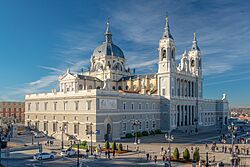
View from the northwest
|
|
| 40°24′56″N 3°42′52″W / 40.415586°N 3.714558°W | |
| Location | Madrid |
| Country | Spain |
| Denomination | Catholic |
| History | |
| Dedication | Virgin of Almudena |
| Consecrated | 15 June 1993 |
| Architecture | |
| Functional status | Cathedral |
| Style | Neoclassical, Neo-Gothic, Neo-Romanesque |
| Years built | 1883 – 1993 |
| Specifications | |
| Length | 102 m (335 ft) |
| Nave width | 12.5 m (41 ft) |
| Number of towers | 2 |
| Tower height | 72 m (236 ft) |
| Administration | |
| Archdiocese | Archdiocese of Madrid |
The Cathedral of Saint Mary the Royal of the Almudena, usually called the Almudena Cathedral, is a large Catholic cathedral in Madrid, Spain. It is the main church for the Archdiocese of Madrid. The cathedral is located right across from the famous Royal Palace.
Building the cathedral took a very long time. Construction started in 1883 and did not finish until 1993, over 100 years later. It was officially opened, or consecrated, by Pope John Paul II.
Contents
History of the Cathedral
Why Madrid Needed a Cathedral
In 1561, the king of Spain moved the country's capital from Toledo to Madrid. However, the main church headquarters stayed in Toledo. This meant that the new capital, Madrid, did not have its own cathedral.
People talked about building a cathedral for the Virgin of Almudena as early as the 1500s. But at the time, Spain was busy building cities and forts in other parts of the world. The country spent its money on its empire, so the cathedral in Madrid had to wait.
Starting the Construction
The first design for the building was for a smaller parish church, created by architect Francisco de Cubas. The first stone was placed in 1883. Two years later, in 1885, Pope Leo XIII created a new church district for Madrid. Because of this, the plans were changed to build a much grander Gothic Revival cathedral.
The cathedral was built on a special site. It is believed that a medieval mosque (a place of worship for Muslims) once stood there. The mosque was destroyed in 1083 when King Alfonso VI captured Madrid.
Delays and a New Design
Construction stopped during the Spanish Civil War (1936-1939). The building site was left empty for many years. In 1950, work started again. A new architect, Fernando Chueca Goitia, changed the plans. He designed the outside of the cathedral in a Baroque style. This was done so it would match the grey and white look of the Royal Palace across the street.
The cathedral was finally finished in 1993. It is dedicated to two patron saints: Santa María la Real de la Almudena and Saint Isidro Labrador.
A famous royal wedding took place in the cathedral on May 22, 2004. The future king, King Felipe VI, married Letizia Ortiz Rocasolano here.
Inside the Cathedral
The inside of the cathedral has a Neo-Gothic style but looks very modern. It is filled with chapels and statues made by modern artists. The styles are very different, from old-fashioned to modern "pop-art."
- The Blessed Sacrament Chapel has beautiful mosaics made by the artist Father Marko Ivan Rupnik.
- The paintings behind the main altar were created by Kiko Argüello, an artist who also started a religious group called the Neocatechumenal Way.
The Crypt
Underneath the main church is a crypt, which is like a stone basement. The crypt is built in a Neo-Romanesque style. It holds a famous 16th-century statue of the Virgen de la Almudena.
Near the cathedral, archaeologists have found the remains of old city walls from medieval times and from when the Moors ruled the area.
Notable People Buried Here
Several important people are buried in the Almudena Cathedral, including:
- Mercedes of Orléans, Queen of Spain (1860–1878)
- Prince Ferdinand of Bavaria (1884–1958)
- Carmen Franco, 1st Duchess of Franco (1926–2017), the daughter of former Spanish leader Francisco Franco.
- Francisco de Cubas (1826–1899), the first architect of the cathedral.
- Cardinal Ángel Suquía Goicoechea (1916–2006), a former Archbishop of Madrid.
Gallery
-
The cathedral as seen from the Royal Palace of Madrid.
-
The tomb of Queen María de las Mercedes of Orleans.
See also
 In Spanish: Catedral de la Almudena para niños
In Spanish: Catedral de la Almudena para niños
- Catholic Church in Spain
- List of tallest domes





